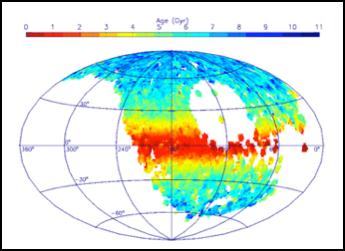Recently, a group of researchers from National Astronomical Observatories of Chinese Academy of Sciences (NAOC), Peking University (PKU) and Beijing Normal University (BNU) have obtained robust age and mass estimates for a million main-sequence turnoff and subgiant (MSTO-SG) stars observed by the LAMOST Galactic Spectroscopic Surveys. The authors estimate ages of the MSTO-SG stars with a Bayesian method, using stellar parameters from the LAMOST DR4 value-added catalog, which contains robust stellar atmospheric parameters, absolute magnitudes, surface gravity, metallicity, abundance, extinction, distance and kinematics for more than 4 million stars. Age estimates for nearly half of the sample stars have uncertainties of only 20–30 per cent. The work enlarges the sample size of stars with available robust age estimates by more than 2 magnitudes. The stars have multi-dimensional parameters, including 3D positions, 3D velocity, mass, age, metallicity and abundances, and have also a perfect spatial coverage to the Galactic disk with very simple selection function. These advantages make the LAMOST MSTO-SG stars a unique sample to unravel the stellar populations, structure, assemblage and evolution history of the Milky Way, especially the disk.
Age is one of the key parameters determining the evolutionary state of a star. Obtaining reliable age for large numbers of stars is a key to characterizing the stellar populations as well as revealing the assemblage and evolution history of the Galaxy. However, deriving stellar age is extremely challenging as there is no accurate clock that records the age of a star. Unlike other parameters, such as mass and chemical composition, it is almost impossible to derive the age of a star directly from observables or based on fundamental physic laws. One has to rely on stellar evolutionary models to obtain stellar age – usually inferred by comparing stellar parameters deduced from observables with model predictions. While this requires accurate and precise stellar parameters, such as effective temperature, metallicity, surface gravity and luminosity, and the method is only applicable to limited types of stars whose observables are sensitive enough to the age. Because of these difficulties, ages for a large sample of Galactic field stars are still absent in spite of several large-scale surveys, both photometric and spectroscopic, having been carried out in the past decades, delivering positions, colors, spectral types, kinematics, and chemistry for huge numbers of stars.
With the LAMOST MSTO-SG star sample, the authors find that stars distribute along two sequences in both the age—[Fe/H] and age — [⍺/Fe] spaces, indicating that chemical enrichment history of the Galactic disk may have experienced different processes. One may correspond to the formation of the thick disk, which has started to form at very early epoch and has almost quenched at 8 Gyr ago, while the other process may correspond to the formation of the thin disk, which has started to form at 8 – 10 Gyr ago, and is still growing at present. The data also reveal a flaring phenomenon of the outer disk in stellar age distribution — young stars tend to reach larger heights above the disk mid-plane at the outer disk, which is expected to provide strong constrains on the disk formation scenarios.
The research paper has been published in ApJS (Xiang et al. 2017, ApJS, 232, 2), and can also be found on the arXiv website for a preprint version (arXiv1707.06236). The first author of the paper, Xiang Maosheng, is a LAMOST Fellow, supported by Special Funding for Advanced Users, supported and managed by the Center for Astronomical Mega-Science of Chinese Academy of Sciences ( CAMS). The work is also supported by National Key Basic Research Program of China and Joint Funds of the National Natural Science Foundation of China.

Fig. 1, Distribution of stellar ages in the Galactic coordinate system (l, b). The figure shows that stellar age becomes older with increasing latitudes.

Address: 20A Datun Road, Chaoyang District, Beijing, China code: 100012
Tel: 010-64888708 E-mail: naoc@nao.cas.cn

